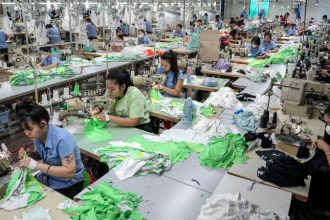The first half of President Donald Trump’s second term has seen significant policy changes, such as sweeping tariffs, increased deportations, federal spending reductions, and layoffs in the government workforce. These measures are poised to fundamentally alter the American economy and its position in the global market.
While the full effects of these policies may take time to be reflected in economic data, their indirect consequences are already observable. In June, the US private sector experienced job losses for the first time in more than two years, according to new data from payroll processor ADP, which reported a decline of approximately 33,000 jobs.
This data contrasts sharply with economists’ forecasts, which had predicted an increase of 117,500 jobs as per FactSet. Nela Richardson, ADP’s chief economist, noted that employers’ stalled hiring plans were a primary factor behind the losses. “Though layoffs continue to be rare, a hesitancy to hire and a reluctance to replace departing workers led to job losses last month,” she explained. “Still, the slowdown in hiring has yet to disrupt pay growth.”
It’s important to note that ADP’s figures do not always align with the official federal jobs report; for instance, March’s preliminary loss of 53,000 jobs was later revised to a net gain of 48,000 private-sector jobs, aided by 30,000 jobs from state and local governments. Nevertheless, ADP’s data is frequently viewed as an indicator of overall hiring trends and wage growth. March 2023 represented the slowest monthly gain since December 2020.
Economists anticipate the Department of Labor’s employment report, set to be released Thursday at 8:30 a.m. ET, will report an addition of 115,000 jobs in June, a decrease from the initial estimate of 139,000 jobs for May, according to FactSet. Additionally, the unemployment rate is expected to rise by 0.1 percentage points to 4.3%, potentially the highest rate since October 2021.
Wednesday’s ADP data marks the first negative reading since March 2023, and according to economist Abiel Reinhart from JPMorgan, it reflects a broader trend of weakening in the job market. Reinhart pointed out that the average discrepancy between ADP and the Bureau of Labor Statistics (BLS) has been around 75,000 jobs over the past year, often due to the BLS’s higher initial estimates that are later revised downwards. He stated, “But the bigger story here beyond the month-to-month forecasting performance of ADP is that the series is clearly weakening, and this has been occurring quite steadily since the start of the year.”
Despite the drop in ADP numbers, some economists have maintained their estimates for Thursday’s report. Economists from Pantheon Macroeconomics, for example, expect private payrolls to increase by 100,000 jobs, which they believe would be substantial enough for the Federal Reserve to hold off on further rate changes this month. The ADP figure has elicited skepticism, particularly regarding the reported loss of 52,000 jobs in health care and education—sectors that typically add an average of 77,000 jobs over the past six months.
However, expectations of weaker job growth in these sectors exist, as seasonal fluctuations typically lead to lower gains in summer. Bank of America economists have noted that this slowdown may be magnified this year due to a stagnant labor market coupled with federal spending cuts.
The negative ADP data appears to have influenced investor sentiment regarding interest rates. CME Group’s FedWatch Tool indicated that expectations for a July rate cut rose slightly from just under 21% to 25% following the report.
As employment policies continue to evolve, their effects on the labor market may take months or even years to fully materialize. Ron Hetrick, a senior labor economist at Lightcast, expressed concerns about the current state of job growth, which he characterized as anemic. Despite initial optimism late last year, uncertainty surrounding tariffs and economic conditions has caused many hiring plans to be postponed. “We were starting to see some excitement toward the end of last year,” Hetrick shared. “When the tariff uncertainty entered in, the Fed got nervous about changing rates, and you just saw all of that retracted overnight.”
This sentiment was echoed by Elizabeth Renter, a senior economist at NerdWallet, who cautioned that ongoing weaknesses in the labor market could leave it vulnerable to future shocks. “It will be months or even years before we see the full effects of tariffs, federal cuts and immigration policies in the labor market,” she said. “But if we continue to see increasing weakness, these things may have a more resounding impact.”
The unemployment rate, usually regarded as a key economic indicator, is showing signs of becoming less reliable. May’s jobs report revealed a steady unemployment rate of 4.2%, even as nearly 91% of job gains stemmed from health care and leisure and hospitality sectors, indicating that deeper issues may be lurking beneath the surface.
Hetrick remarked, “Unemployment is still low, but we’ve got to watch how we get to that unemployment number. If you’re doing it because your labor force is shrinking, you’re not doing it through strength.”
Wells Fargo economists pointed out that foreign-born workers have been crucial to labor force growth since early 2020, but recent immigration restrictions may contribute to a diminishing labor pool. “Whereas immigration overstated the pace of labor market cooling last year, it could now paint an overly rosy picture of its health,” they said. “We expect the unemployment rate to peak at just 4.5% in the year ahead as weaker demand for workers coincides with weaker supply.”
Labor market dynamics reveal a trend of low activity; hiring rates are nearing a decade-long low, with many workers hesitant to change jobs. Meanwhile, employers are predominantly retaining their current workforce, and layoff rates have not seen a significant increase lately.
Challenger, Gray & Christmas released a report highlighting that in June, US employers announced 47,999 job cuts, down 49% from May and 2% from June of the previous year. Though layoff announcements typically decline during this period, total layoffs for the year are still following an elevated trend relative to pre-pandemic levels.
Job cut announcements related to the Trump administration’s initiatives, including the Department of Government Efficiency, contributed significantly to this year’s totals. Despite these announcements, many of these projected cuts have yet to translate into actual layoffs, as not all affected federal employees were let go immediately, and some have been reinstated.
As of May, federal employment has contracted by about 56,000 positions since February, but the federal workforce represents only a small fraction of total employment. On Thursday, jobless claims data will be updated alongside the employment report, indicating that while initial claims have been rising, ongoing claims are at near four-year highs, suggesting a tougher job market for many.
Daniel Zhao, an economist at Glassdoor, noted, “The early impacts of tariffs are just one drag on the job market. A bevy of other headwinds are accumulating,” indicating that while no single factor might trigger a recession, the cumulative impact poses significant risks to job growth ahead of potential tariff shocks.











